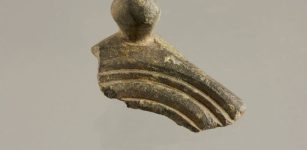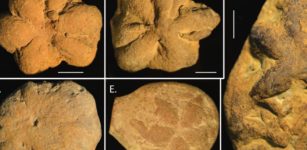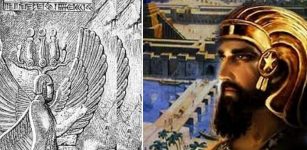Ouroboros – Cosmic Serpent And The Self-Devourer – Universal, Powerful Symbol Of Great Antiquity
A. Sutherland - AncientPages.com - Widely known in many religions worldwide from Europe, Asia, and Africa, this mystical, very old symbol means "the end is the beginning." It has the ability to reproduce itself. It mates, impregnates, and destroys itself, and all this happens in the cycle of time.
An ouroboros in a 1478 drawing in an alchemical tract. Anonymous medieval illuminator. Image credit: uploader Carlos adanero - Public Domain
Artifacts in the form of bracelets with this symbol are found in areas occupied by the Slavs beginning with the first European Neolithic cultures. The ancient Greeks considered Ouroboros a serpent or a worm engulfing its tail and forming a circle with the beginning and the end.
The same was also an interpretation of the symbol in other cultures because Ouroboros' means always the same: an eternal cyclic force – both destructive and at the same time, crucial as a part of nature's process of regeneration.
Cosmic cycle - wheel appears half as light and half as darkness; in this form, it is Yang and Yin. Ouroboros means 'life conflict' when life passes and death comes. Still, the end also means the beginning.
It is also a union of opposites, Heaven and Earth working together and consistently in harmony.
Ancient engravings of Ouroboros, dated to the Chou dynasty in China (1200 BC), symbolize the continuity of life with the dragon biting his tail and in a mythical monster called the Midgard serpent—also known as Jormungand, encircled the world, biting its tail.
Engraving of a wyvern-type ouroboros by Lucas Jennis, in the 1625 alchemical tract De Lapide Philosophico. The figure serves as a symbol for Mercury. source
The circle is also a symbol of perfection like the halo that is drawn over the heads of the Byzantine images of the saints—believed to be inspired by the Milky Way and described in ancient writings as a luminous serpent (serpent of light) that dwells in high heavens. Ouroboros is associated with Hermetism alchemy. It speaks of purity, wholeness, and infinity. Gnostic belief "passes through all things" as the symbol of the inseparable, the "unchanging law" that applies to all things and connects between them.
Generally, the symbol's meaning remains the same – eternal cyclic force is both destructive and regenerative.
Hermes - the god of alchemy - defines the Ouroboros as: "Serpens cuius caudam devorabit, "a snake that devours its own tail, symbolizes the alchemical Mercury represents the cosmic unity and the circular nature of the work of the alchemist.
Ouroboros, which symbolizes the cyclical nature of the universe and a path to the sun, was already known to ancient Egyptians around 1600 BC. Still, it is likely to be even much older than this.
From there, knowledge about Ouroboros moved to the Phoenicians and to the Greeks and took a distinguished place in myths of Vikings (Norse,) Hindus, tribes of Central America, West Africa, Voodoo beliefs,
The Ouroboros concept appears elsewhere.
Updated on March 7, 2024
Written by – A. Sutherland AncientPages.com Staff Writer
Copyright © AncientPages.com All rights reserved. This material may not be published, broadcast, rewritten or redistributed in whole or part without the express written permission of AncientPages.com
Expand for referencesMore From Ancient Pages
-
 Mysterious Gobi Sea And A Huge Land Inhabited By The Real Sons Of God
Featured Stories | Aug 20, 2018
Mysterious Gobi Sea And A Huge Land Inhabited By The Real Sons Of God
Featured Stories | Aug 20, 2018 -
 When Did Humans First Start To Speak?
Featured Stories | Dec 12, 2022
When Did Humans First Start To Speak?
Featured Stories | Dec 12, 2022 -
 Mysterious Cave With Giant Skulls Decorated By The Neanderthals Discovered In Spain
Archaeology | Jan 27, 2023
Mysterious Cave With Giant Skulls Decorated By The Neanderthals Discovered In Spain
Archaeology | Jan 27, 2023 -
 Remarkable Marble Fragment From The Temple Of Zeus In Akragas Found Underwater Off The Coast Of Sicily
Archaeology | Feb 6, 2024
Remarkable Marble Fragment From The Temple Of Zeus In Akragas Found Underwater Off The Coast Of Sicily
Archaeology | Feb 6, 2024 -
 Assyrian King Ashurbanipal’s Great Library With Thousands Of Cuneiform Tablets
Civilizations | Dec 9, 2015
Assyrian King Ashurbanipal’s Great Library With Thousands Of Cuneiform Tablets
Civilizations | Dec 9, 2015 -
 Yokai Amabie – Protective Ancient Spirit That Can Ward Off Epidemics
Featured Stories | Mar 30, 2020
Yokai Amabie – Protective Ancient Spirit That Can Ward Off Epidemics
Featured Stories | Mar 30, 2020 -
 Incamisana Water Temple At Ollantaytambo, Peru: Marvelous Engineering Masterpiece Of Inca
Ancient Technology | Jul 19, 2019
Incamisana Water Temple At Ollantaytambo, Peru: Marvelous Engineering Masterpiece Of Inca
Ancient Technology | Jul 19, 2019 -
 Fragments Of Oldest Pharaonic Military Fortress Unearthed In Egypt’s North Sinai
Archaeology | May 20, 2019
Fragments Of Oldest Pharaonic Military Fortress Unearthed In Egypt’s North Sinai
Archaeology | May 20, 2019 -
 Mystery Of The Delphi Oracle Prophecies: Was Pythia On Drugs While Guiding Ancient Greek Civilization For Thousands Of Years?
Civilizations | Nov 3, 2016
Mystery Of The Delphi Oracle Prophecies: Was Pythia On Drugs While Guiding Ancient Greek Civilization For Thousands Of Years?
Civilizations | Nov 3, 2016 -
 Piece Of Puzzling Roman Artifact Discovered In Belgium
Archaeology | Feb 16, 2023
Piece Of Puzzling Roman Artifact Discovered In Belgium
Archaeology | Feb 16, 2023 -
 Ancient DNA Reveals Irish Are Not Celts – Irish Ancestors Came From Biblical Lands – Scientists Say
Archaeology | Mar 30, 2020
Ancient DNA Reveals Irish Are Not Celts – Irish Ancestors Came From Biblical Lands – Scientists Say
Archaeology | Mar 30, 2020 -
 Long-Forgotten Ancient Book Contains Extensive Scientific Survey Of North America Made 4,500 Years Ago
Ancient Mysteries | Jul 26, 2019
Long-Forgotten Ancient Book Contains Extensive Scientific Survey Of North America Made 4,500 Years Ago
Ancient Mysteries | Jul 26, 2019 -
 On This Day In History: Dramatic Battle Of Öland – On June 1, 1676
News | Jun 1, 2016
On This Day In History: Dramatic Battle Of Öland – On June 1, 1676
News | Jun 1, 2016 -
 Did The Dogon Tribe Have Knowledge Of Theoretical Physics 5,000 Years Ago?
Ancient Mysteries | Aug 2, 2017
Did The Dogon Tribe Have Knowledge Of Theoretical Physics 5,000 Years Ago?
Ancient Mysteries | Aug 2, 2017 -
 Mysterious Ancient Star-Shaped ‘Fossil’ Baffles Scientists – What Is It?
Archaeology | Feb 27, 2023
Mysterious Ancient Star-Shaped ‘Fossil’ Baffles Scientists – What Is It?
Archaeology | Feb 27, 2023 -
 Cyrus The Great: Founder Of Achaemenid Empire Who Conquered Medians, Lydians And Babylonians
Featured Stories | Mar 21, 2019
Cyrus The Great: Founder Of Achaemenid Empire Who Conquered Medians, Lydians And Babylonians
Featured Stories | Mar 21, 2019 -
 The Oldest Denisovan Fossils Ever Discovered Shed New Light On Early Hominins As They Spread Across Eurasia
Archaeology | Nov 30, 2021
The Oldest Denisovan Fossils Ever Discovered Shed New Light On Early Hominins As They Spread Across Eurasia
Archaeology | Nov 30, 2021 -
 Artifacts Discovered At Yirra Confirm Aboriginal People Lived In Pilbara During The Last Ice Age
Archaeology | Apr 12, 2022
Artifacts Discovered At Yirra Confirm Aboriginal People Lived In Pilbara During The Last Ice Age
Archaeology | Apr 12, 2022 -
 Goddess Huitaca – Moon Goddess Of Intoxication, Joyful Life And Unlimited Pleasures In Muisca Mythology
Featured Stories | Mar 14, 2021
Goddess Huitaca – Moon Goddess Of Intoxication, Joyful Life And Unlimited Pleasures In Muisca Mythology
Featured Stories | Mar 14, 2021 -
 Old Babylonian Residential Building In Ur Dated To 1835 BC – Investigated
Archaeology | Jul 24, 2019
Old Babylonian Residential Building In Ur Dated To 1835 BC – Investigated
Archaeology | Jul 24, 2019


